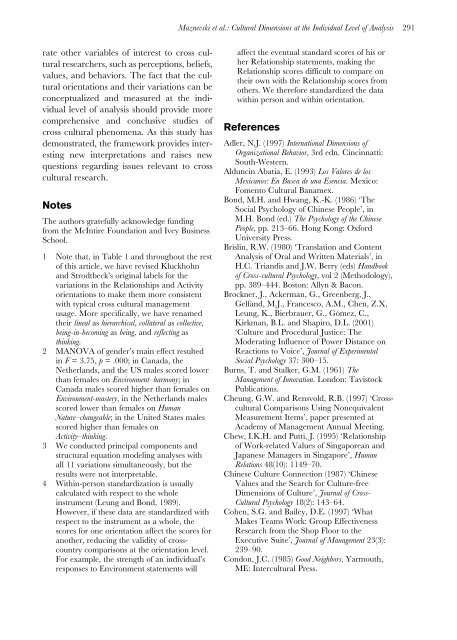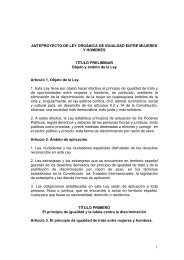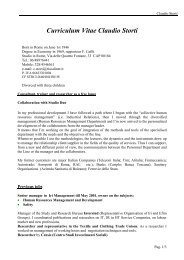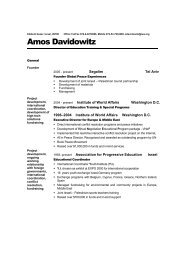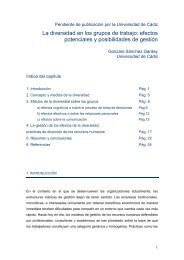Cultural dimensions - IMD
Cultural dimensions - IMD
Cultural dimensions - IMD
Create successful ePaper yourself
Turn your PDF publications into a flip-book with our unique Google optimized e-Paper software.
Maznevski et al.: <strong>Cultural</strong> Dimensions at the Individual Level of Analysis 291rate other variables of interest to cross culturalresearchers, such as perceptions, beliefs,values, and behaviors. The fact that the culturalorientations and their variations can beconceptualized and measured at the individuallevel of analysis should provide morecomprehensive and conclusive studies ofcross cultural phenomena. As this study hasdemonstrated, the framework provides interestingnew interpretations and raises newquestions regarding issues relevant to crosscultural research.NotesThe authors gratefully acknowledge fundingfrom the McIntire Foundation and Ivey BusinessSchool.1 Note that, in Table 1 and throughout the restof this article, we have revised Kluckhohnand Strodtbeck’s original labels for thevariations in the Relationships and Activityorientations to make them more consistentwith typical cross cultural managementusage. More specifically, we have renamedtheir lineal as hierarchical, collateral as collective,being-in-becoming as being, and reflecting asthinking.2 MANOVA of gender’s main effect resultedin F = 3.75, p = .000; in Canada, theNetherlands, and the US males scored lowerthan females on Environment–harmony; inCanada males scored higher than females onEnvironment-mastery, in the Netherlands malesscored lower than females on HumanNature–changeable; in the United States malesscored higher than females onActivity–thinking.3 We conducted principal components andstructural equation modeling analyses withall 11 variations simultaneously, but theresults were not interpretable.4 Within-person standardization is usuallycalculated with respect to the wholeinstrument (Leung and Bond, 1989).However, if these data are standardized withrespect to the instrument as a whole, thescores for one orientation affect the scores foranother, reducing the validity of crosscountrycomparisons at the orientation level.For example, the strength of an individual’sresponses to Environment statements willaffect the eventual standard scores of his orher Relationship statements, making theRelationship scores difficult to compare ontheir own with the Relationship scores fromothers. We therefore standardized the datawithin person and within orientation.ReferencesAdler, N.J. (1997) International Dimensions ofOrganizational Behavior, 3rd edn. Cincinnatti:South-Western.Alduncin Abatia, E. (1993) Los Valores de losMexicanos: En Busca de una Esencia. Mexico:Fomento <strong>Cultural</strong> Banamex.Bond, M.H. and Hwang, K.-K. (1986) ‘TheSocial Psychology of Chinese People’, inM.H. Bond (ed.) The Psychology of the ChinesePeople, pp. 213–66. Hong Kong: OxfordUniversity Press.Brislin, R.W. (1980) ‘Translation and ContentAnalysis of Oral and Written Materials’, inH.C. Triandis and J.W. Berry (eds) Handbookof Cross-cultural Psychology, vol 2 (Methodology),pp. 389–444. Boston: Allyn & Bacon.Brockner, J., Ackerman, G., Greenberg, J.,Gelfand, M.J., Francesco, A.M., Chen, Z.X,Leung, K., Bierbrauer, G., Gómez, C.,Kirkman, B.L. and Shapiro, D.L. (2001)‘Culture and Procedural Justice: TheModerating Influence of Power Distance onReactions to Voice’, Journal of ExperimentalSocial Psychology 37: 300–15.Burns, T. and Stalker, G.M. (1961) TheManagement of Innovation. London: TavistockPublications.Cheung, G.W. and Rensvold, R.B. (1997) ‘CrossculturalComparisons Using NonequivalentMeasurement Items’, paper presented atAcademy of Management Annual Meeting.Chew, I.K.H. and Putti, J. (1995) ‘Relationshipof Work-related Values of Singaporean andJapanese Managers in Singapore’, HumanRelations 48(10): 1149–70.Chinese Culture Connection (1987) ‘ChineseValues and the Search for Culture-freeDimensions of Culture’, Journal of Cross-<strong>Cultural</strong> Psychology 18(2): 143–64.Cohen, S.G. and Bailey, D.E. (1997) ‘WhatMakes Teams Work: Group EffectivenessResearch from the Shop Floor to theExecutive Suite’, Journal of Management 23(3):239–90.Condon, J.C. (1985) Good Neighbors. Yarmouth,ME: Intercultural Press.


